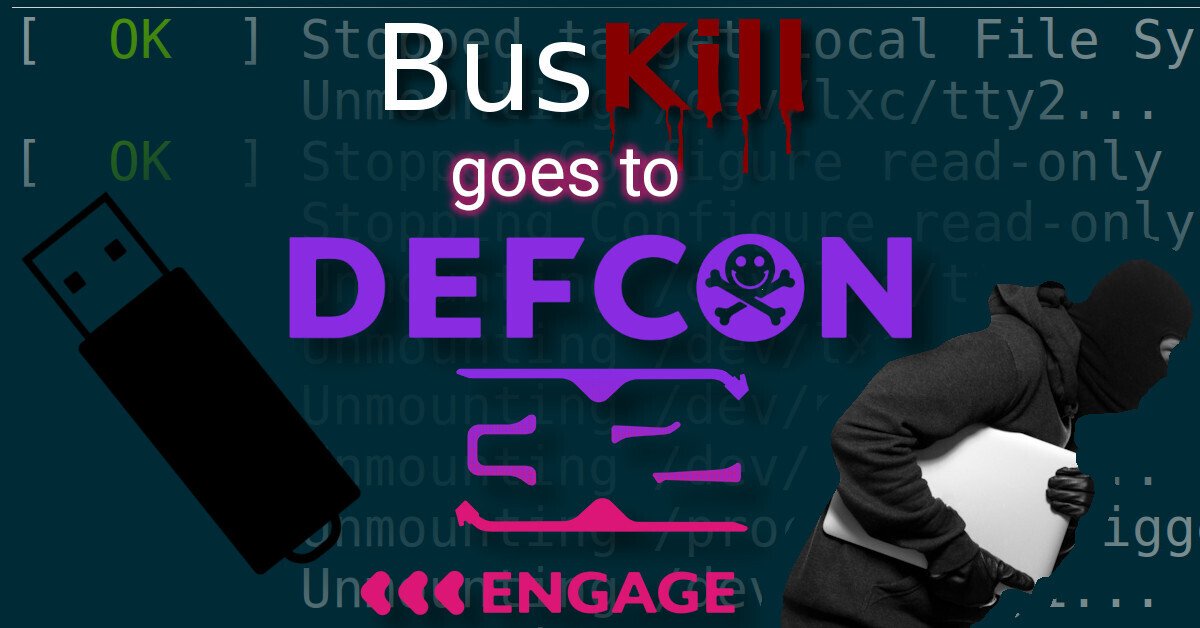We’re very happy to share Techlore’s video review of the BusKill Kill Cord.
Can’t see video above? Watch it on PeerTube at neat.tube or on YouTube at youtu.be/Zns0xObbOPM
We’re very happy to share Techlore’s video review of the BusKill Kill Cord.
Can’t see video above? Watch it on PeerTube at neat.tube or on YouTube at youtu.be/Zns0xObbOPM
This post contains a canary message that’s cryptographically signed by the official BusKill PGP release key
For more information about BusKill canaries, see:
🇳🇱 Nederlandse versie van dit artikel
🇫🇷 Version française de cet article
🇩🇪 Deutsche Version dieses Artikels
We’re happy to announce that BusKill cables can now be purchased in-person in Haaksbergen, Netherlands.
The BusKill project has partnered with NovaCustom to make BusKill laptop kill cords available from another brick-and-mortar location in Europe. You can now go to the following location and purchase a BusKill cable with cash or cryptocurrency.
NovaCustom B.V.
Harmoleweg 4
7482 PL Haaksbergen
Netherlands
(only by appointment)
🇬🇧 English version of this article.
🇳🇱 Nederlandse versie van dit artikel
🇩🇪 Deutsche Version dieses Artikels
Nous sommes heureux d’annoncer que les câbles BusKill peuvent désormais être achetés en personne à Haaksbergen, aux Pays-Bas.
🇬🇧 English version of this article.
🇫🇷 Version française de cet article
🇩🇪 Deutsche Version dieses Artikels
We kunnen met trots mededelen dat de BusKill-kabels vanaf nu bij het bedrijf NovaCustom persoonlijk aan te schaffen zijn in Haaksbergen, Nederland.
🇬🇧 English version of this article.
🇳🇱 Nederlandse versie van dit artikel
🇫🇷 Version française de cet article
Mit großem Stolz präsentieren wir unsere neue Zusammenarbeit mit NovaCustom. Ab jetzt können Buskill-Kabel physisch im Büro bei NovaCustom in Haaksbergen (Niederlande) gekauft werden.
In celebration of Bitcoin Black Friday 2024, we’re offering a 10% discount on all BusKill cables sold between Nov 23 to Dec 07.
We’re happy to announce that BusKill is presenting at DEF CON 32.
What: Open Hardware Design for BusKill Cord
When: 2024-08-10 12:00 – 13:45
Where: W303 – Third Floor – LVCC West Hall

Update 2024-09-04 Added slide deck pdf
This post contains a canary message that’s cryptographically signed by the official BusKill PGP release key
For more information about BusKill canaries, see:
Today we’re ecstatic to publish our first demo showing a homemade BusKill Cable (in the prototype 3D-printed case) triggering a lockscreen.
While we do what we can to allow at-risk folks to purchase BusKill cables anonymously, there is always the risk of interdiction.
We don’t consider hologram stickers or tamper-evident tape/crisps/glitter to be sufficient solutions to supply-chain security. Rather, the solution to these attacks is to build open-source, easily inspectable hardware whose integrity can be validated without damaging the device and without sophisticated technology.
Actually, the best way to confirm the integrity of your hardware is to build it yourself. Fortunately, BusKill doesn’t have any circuit boards, microcontrollers, or silicon; it’s trivial to print your own BusKill cable — which is essentially a USB extension cable with a magnetic breakaway in the middle
Mitigating interdiction via 3D printing is one of many reasons that Melanie Allen has been diligently working on prototyping a 3D-printable BusKill cable this year. In this article, we hope to showcase her progress and provide you with some OpenSCAD and .stl files you can use to build your own version of the prototype, if you want to help us test and improve the design.
ⓘ Note: This post is adapted from its original article on Melanie Allen’s blog.
In our last update, I showed a video demo where I succesfully triggered a lockscreen using a BusKill prototype without the 3D-printed body for the case and N35 disc magnets. I realized that the N35 disc magnets were not strong enough. In this update, I show a demo with the prototype built inside a 3D-printed case and with (stronger) N42 and N52 cube magnets.
Can’t see video above? Watch it on PeerTube or on YouTube at youtu.be/vFTQatw94VU